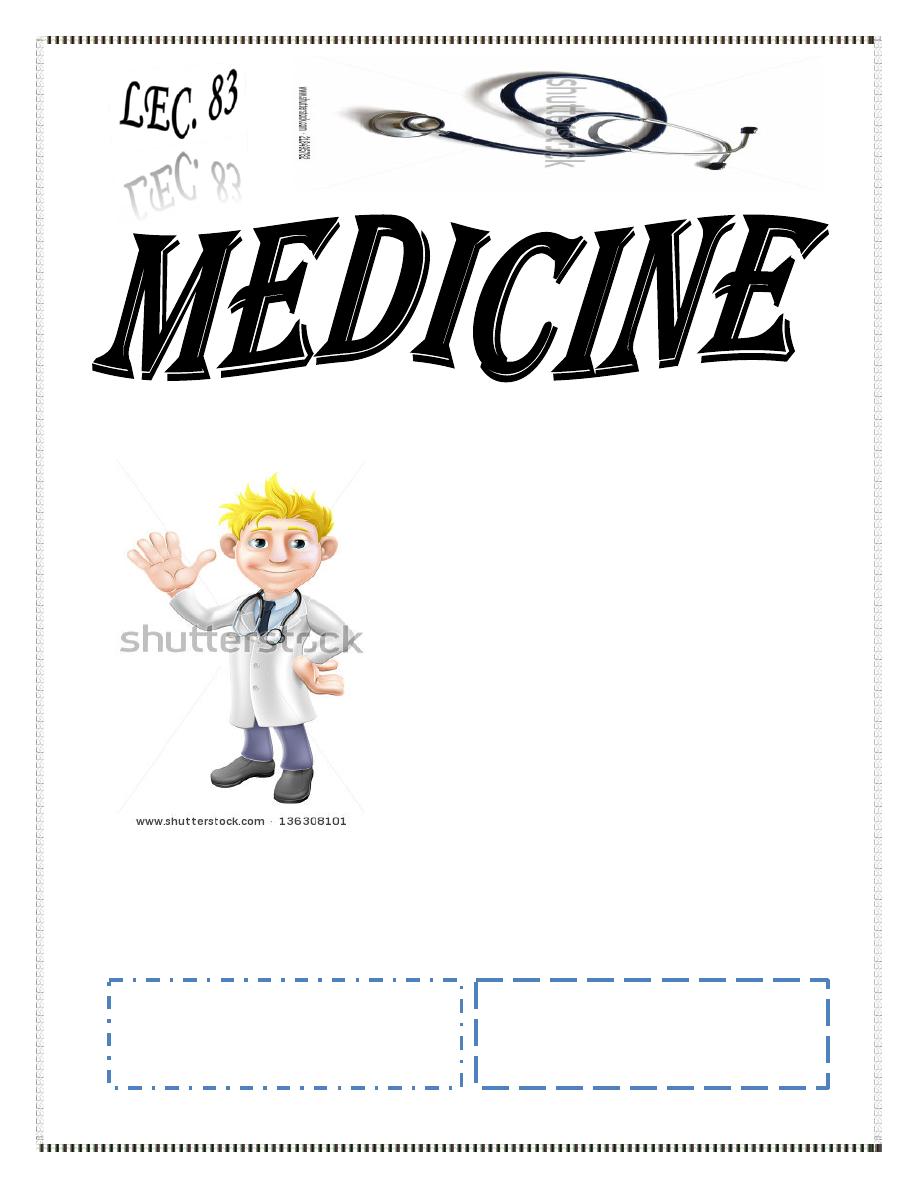
Dr. Khalid A. Al- Khazraji
Lec. 12
CIRRHOSIS & ITS SEQELAE –
PART 2
Thur. 21 / 4 / 2016
Done By: Ibraheem Kais
2015 – 2016
ﻣﻜﺘﺐ ﺁ
ﺷﻮﺭ ﻟﻼﺳﺘﻨﺴﺎﺥ

Cirrhosis & its sequelae Dr. Khalid A. Al- Khazraji
Part - 2
21-4-2016
1
Cirrhosis & its sequelae – Part 2
Complications of Cirrhosis
Varices and variceal hemorrhage
Upper GI endoscopy is the main method for diagnosing varices and variceal
hemorrhage.
Varices are classified as small (straight, minimally elevated veins above the
esophageal mucosal surface), medium (tortuous veins occupying less than
one third of the esophageal lumen), or large (occupying more than one third
of the esophageal lumen).
Ascites
The most common cause of ascites is cirrhosis, which accounts for 80% of
cases. Diagnostic paracentesis is a safe procedure. Ultrasound guidance
should be used in patients in whom percussion cannot locate the ascites.
The fluid should always be evaluated for albumin, polymorphonuclear (PMN)
blood cell count, bacteriologic cultures, cytology, glucose and lactate
dehydrogenase levels, smear and culture for acid-fast bacilli.
The serum-ascites albumin gradient useful in the differential diagnosis of
ascites. The serum-ascites albumin gradient correlates with sinusoidal
pressure and will therefore be elevated (>1.1 g/ dL) in patients in whom the
source of ascites is the hepatic sinusoid (e.g., cirrhosis or cardiac ascites).

Cirrhosis & its sequelae Dr. Khalid A. Al- Khazraji
Part - 2
21-4-2016
2
Hepatorenal syndrome
Characterized by maximal peripheral vasodilation, maximal activation of
hormones that cause the retention of sodium and water and intense
vasoconstriction of renal arteries. Ascites unresponsive to diuretics is
universal, and dilutional hyponatremia is almost always present.
Spontaneous bacterial peritonitis
Diagnostic paracentesis should be performed in any patient with symptoms or
signs of spontaneous bacterial peritonitis.
Spontaneous bacterial peritonitis is often asymptomatic.
The diagnosis of spontaneous bacterial peritonitis is established by an ascitic
fluid PMN count greater than 250/ mm3.
Bacteria can be isolated from ascitic fluid in only 40 to 50% of cases.
Spontaneous bacterial peritonitis is mostly a monobacterial infection, usually
with gram-negative enteric organisms. Anaerobes and fungi are very rare
causes.
Hepatic encephalopathy
o The diagnosis is based on the history and physical examination.
o There is poor correlation between the stage of hepatic encephalopathy and
ammonia blood levels.

Cirrhosis & its sequelae Dr. Khalid A. Al- Khazraji
Part - 2
21-4-2016
3
Hepatopulmonary syndrome and portopulmonary hypertension
The diagnostic criteria for hepatopulmonary syndrome are arterial
hypoxemia with a PaO2 of less than 80 mm Hg, or an alveolar arterial
oxygen gradient of greater than 15 mm Hg, along with evidence of pulmonary
vascular shunting on contrast echocardiography.
Portopulmonary hypertension is diagnosed by the presence of mean
pulmonary arterial pressure higher than 25 mm Hg on right heart
catheterization, provided that pulmonary capillary wedge pressure is less
than 15 mm Hg.
TREATMENT
Treatment of cirrhosis should ideally be aimed at interrupting or reversing
fibrosis.
Treatment of compensated cirrhosis is currently directed at preventing the
development of decompensation by:
1. Treating the underlying liver disease (e.g., antiviral therapy for hepatitis C
or B) to reduce fibrosis and prevent decompensation;
2. Avoiding factors that could worsen liver disease, such as alcohol and
hepatotoxic drugs; and
3. Screening for varices (to prevent variceal hemorrhage) and for
hepatocellular carcinoma (to treat at an early stage).

Cirrhosis & its sequelae Dr. Khalid A. Al- Khazraji
Part - 2
21-4-2016
4
Varices and variceal bleeding
Reducing portal pressure. Nonselective β-adrenergic blockers (propranolol,
nadolol) reduce portal pressure by producing.
Splanchnic vasoconstriction and decreasing portal venous inflow. 1-
Propranolol should be titrated to produce a resting heart rate of about 50 to
55 beats per minute.
Endoscopic variceal ligation.
Endoscopy should be repeated every 2 to 3 years in patients with no varices,
every 1 to 2 years in patients with small varices.
The most effective specific therapy for the control of active variceal
hemorrhage is the combination of a vasoconstrictor with endoscopic therapy.
Safe vasoconstrictors include terlipressin, and the somatostatin analogues,
octreotide, which is used as a 50-μg intravenous bolus followed by an
infusion at 50 μg/ hour.
The next best results (rebleeding rates of about 22%) are obtained with the
combination of nonselective β-blockers (propranolol or nadolol), with or
without isosorbide mononitrate, and endoscopic variceal ligation.
Trans-jugular intrahepatic portosystemic shunt (TIPS), should be used in
patients whose variceal bleeding has persisted.

Cirrhosis & its sequelae Dr. Khalid A. Al- Khazraji
Part - 2
21-4-2016
5
Ascites
Salt restriction and diuretics constitute the mainstay of management of
ascites. Dietary sodium intake should be restricted to 2 g/ day.
Spironolactone, should be started at a dose of 100 mg/ day to a maximal
effective dose of 400 mg/ day.
Furosemide, at an escalated dose from 40 to 160 mg/ day.
The goal is weight loss of 1 kg in the first week and 2 kg/ week subsequently.
In the 10 to 20% of patients with ascites who are refractory to diuretics,
large-volume paracentesis, aimed at removing all or most of the fluid, plus
albumin at a dose of 6 to 8 g intravenously per liter of ascites removed.
In patients requiring frequent large-volume paracentesis (more than twice per
month), polytetrafluoroethylene-covered TIPS.
- Stents should be considered.
Hepatorenal syndrome
The mainstay of therapy is liver transplantation.
Terlipressin, plus albumin.
Use of terlipressin, which at a dose 0.5 to 2.0 mg intravenously every 4 to 6
hours.
The most used combination is octreotide (100 to 200 μg subcutaneously three
times a day) plus midodrine.

Cirrhosis & its sequelae Dr. Khalid A. Al- Khazraji
Part - 2
21-4-2016
6
Spontaneous bacterial peritonitis
Empirical antibiotic therapy with an intravenous third-generation
cephalosporin. The minimal duration of therapy should be 5 days. Repeat
diagnostic paracentesis should be performed 2 days after starting antibiotics.
The renal dysfunction associated with spontaneous bacterial peritonitis can
be prevented by the intravenous administration of albumin, Albumin has been
used at a dose of 1.5 g/ kg of body weight at diagnosis.
Hepatic encephalopathy
o Treating the precipitating factor and reducing the ammonia level.
Precipitating factors include infections, overdiuresis, GI bleeding, a high oral
protein load, and constipation. Narcotics and sedatives contribute to hepatic
encephalopathy by directly depressing brain function.
o Lactulose (15 to 30 mL) orally twice daily or orally administered
nonabsorbable antibiotics such as neomycin, metronidazole (250 mg two to
four times per day), or rifaximin (550 mg two times per day).
o Switching dietary protein from an animal source to a vegetable source may be
beneficial.
Pulmonary complications
Hepatopulmonary syndrome The only viable treatment is liver
transplantation.

Cirrhosis & its sequelae Dr. Khalid A. Al- Khazraji
Part - 2
21-4-2016
7
PROGNOSIS
The 10-year survival rate of patients who remain in a compensated stage is
approximately 90%, whereas their likelihood of decompensation is 50% at 10
years.
Four clinical stages of cirrhosis:
- Stage 1 patients without varices or ascites, the mortality rate is about 1%
per year.
- Stage 2 patients, or those with varices but without ascites or bleeding, have
a mortality rate of about 4% per year.
- Stage 3 patients have ascites with or without esophageal varices that have
never bled; their mortality rate while remaining in this stage is 20% per
year.
- Stage 4 patients, or those with portal hypertensive GI bleeding with or
without ascites, have a 1-year mortality rate of 57%, with nearly half of
these deaths occurring within 6 weeks after the initial episode of bleeding.
Hepatocellular carcinoma develops at a fairly constant rate of 3% per year.
… End …
